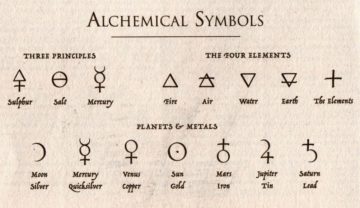
In honor of our collaboration with the Tucson Symphony Orchestra, we present “The Marriage of the Sun and Moon,” an homage to the roots of Western classical thought, drawing on the artistry of Medieval and Renaissance alchemical and hermetic texts.
Modern science has its roots in the alchemical experiments of ancient Greece and Hellenic Egypt, Medieval and Renaissance Europe, and the classical Islamic world.
Alchemy was the mystical and protoscientific practice of attempting to transform elements from base (lead) to noble (gold), seeking means to extend life, searching for cures and knowledge both metaphysical and mundane. It tangled the material and the spiritual together and attempted to use one—the material world—to affect the other—the spiritual.
Alchemists broke things down to the simplest elements that they could, named the pieces, devised symbols to represent them, and then figured out how to put them back together to make something new. They were fascinated by the combinations and conjunctions, aiming always to find a result that was greater than the sum of the elements that went into it—the elixir of life, the universal solvent, the Philosopher’s Stone. And their work was infused with mysticism, with soul and spirit, with arcane knowledge, with purification and the pursuit of enlightenment.
As they documented their findings, many times the symbols they used represented not only elemental interactions in the material world, but also carried a metaphorical story about the metaphysical transformation of the practitioner. The spiritual hidden in the material.

The Union of Opposites
Many alchemical texts contain illustrations of the marriage of the sun and the moon, king and queen, the masculine and the feminine, fire and air with earth and water, sulphur and mercury—the union of two elements seemingly opposed.
Over the centuries—particularly during the Enlightenment—the spiritual and the scientific began to split, moving away from one another until they became, in our times, discrete opposites. Seemingly irreconcilable poles.
But perhaps they can meet again—forming something new, greater than the sum of the parts. As we learn more about our cosmos there are elements of mystery, of awe bordering on mystical: quantum entanglement, mirror neurons; astonishing discoveries from the tiniest particles to the vastness of galaxies and dark matter, from biofeedback to the impact of trauma on brain function. Concepts we may have thought were opposites we find are less so.
There are stories in modern science that can double as metaphysical parables for the lives of our spirits, our souls.

Symbols of Alchemy
Alchemists wore their symbols on their sleeves. Literally. The cartoon magician’s robes with their stars and moons are a call-back to the ancient alchemists, adorned with symbols, a map of their investigations.
These are the visual elements we will draw on this year: the union of opposites, the symbols of the alchemists, a visual journey from magician to scientist, from ancient to modern.
And we will investigate. Taking the pieces—music, musicians, dancers, performers, costumes, movement, prayers, memories, fire, air, earth, water—and combining them to see what we can make that is greater than the sum of the parts. Please join us in crafting your own experiments to contribute to the whole!